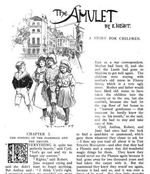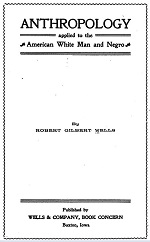|  | | | | 

| | The Amulet
aka The Story of the Amulet
by E. Nesbit
First publication: The Strand Magazine, Apr 1905–Mar 1906

 Edith Nesbit’s Five Children and It about five English children and their wish-granting Psammead never engaged me as a child, nor did her sequels: The Phoenix and the Carpet (1904), and finally The Amulet, which was the only one with time travel. In that third story, the eponymous magic amulet takes them to times that span from ancient Egypt to the future. It was only the amulet that had the power of time travel, and even if I never bonded much with Cyril, Anthea, Robert, Jane, and the baby, I do admire Nesbit for bringing time travel to children’s stories. Edith Nesbit’s Five Children and It about five English children and their wish-granting Psammead never engaged me as a child, nor did her sequels: The Phoenix and the Carpet (1904), and finally The Amulet, which was the only one with time travel. In that third story, the eponymous magic amulet takes them to times that span from ancient Egypt to the future. It was only the amulet that had the power of time travel, and even if I never bonded much with Cyril, Anthea, Robert, Jane, and the baby, I do admire Nesbit for bringing time travel to children’s stories.

The story was initially serialized as The Amulet in twelve monthly issues of The Strand before the book was published in 1906 as The Story of the Amulet. Decades later, the children show up in a cameo in the fourth book of Edward Eager’s Tales of Magic series. Don’t you understand? The thing existed in the Past. If you were in the Past, too, you could find it. It’s very difficult to make you understand things. Time and space are only forms of thought. Don’t you understand? The thing existed in the Past. If you were in the Past, too, you could find it. It’s very difficult to make you understand things. Time and space are only forms of thought. 
| |
| | | | |

 | | | | 

| | Anthropology Applied to the
American White Man and Negro
by Robert Gilbert Wells
First publication: 14 Apr 1905

 I met the amiable and widely read John Clute in New Hampshire in the summer of 2014. He introduced me to this work, which he describes in the Encyclopedia of Science Fiction as a satire of race relations in post-Reconstruction America. For the most part, the story takes place as a conversation between a black man, Sam Brown, and his white brother, Boss Jones. As such, it’s a subtle satire, using the “science of Anthropology” to warn us of the laziness of the Negro, the greed of the white man, and the evils of incompatible matings, among other things. I met the amiable and widely read John Clute in New Hampshire in the summer of 2014. He introduced me to this work, which he describes in the Encyclopedia of Science Fiction as a satire of race relations in post-Reconstruction America. For the most part, the story takes place as a conversation between a black man, Sam Brown, and his white brother, Boss Jones. As such, it’s a subtle satire, using the “science of Anthropology” to warn us of the laziness of the Negro, the greed of the white man, and the evils of incompatible matings, among other things.

Clute classifies the work as having numerous fantastic elements including when Sam and the author Bob Wells leave their bodies to invisibly view other happenings, at least one small bit of time travel, and the one item that’s of most interest: a potion that changes Mr. Jones into a Negro for the span of a train journey.

Whatever time travel does exist, such as a possible visit by Mr. Jones to 16th century Greece, is subtle compared to the other aspects of the satire. The doors and windows were opened, Sam and Mr. Jones walked out of the room, then to the depot purchased tickets and started for Chicago, but when the two men arrived at the depot, to Mr. Jones surprise, the ticket agent told him to get out of that waiting room or he would take a club to his head, and that pretty quick. The doors and windows were opened, Sam and Mr. Jones walked out of the room, then to the depot purchased tickets and started for Chicago, but when the two men arrived at the depot, to Mr. Jones surprise, the ticket agent told him to get out of that waiting room or he would take a club to his head, and that pretty quick. 
| |
| | | | |

 
No Time Travel. Move along. |
“The Time Reflector” by George Allan England, Monthly Story Magazine, Sep 1905 [viewing the past ]

| |     |